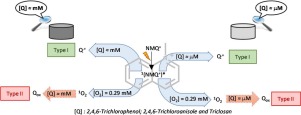Journal of Hazardous Materials ( IF 12.2 ) Pub Date : 2018-03-08 , DOI: 10.1016/j.jhazmat.2018.03.010 Rebeca Martinez-Haya , Consuelo Sabater , Maria-Ángeles Castillo , Miguel A. Miranda , M. Luisa Marin

|
Photocatalytic degradation of three highly chlorinated contaminants, namely 2,4,6-trichlorophenol (TCP), 2,4,6-trichloroanisole (TCA) and 5-chloro-2-(2,4-dichlorophenoxy)phenol (triclosan, TCS) has been investigated in the presence of N-methylquinolinium tetrafluoroborate (NMQ+), a photocatalyst able to act via Type I or Type II mechanism. Photodegradation of contaminants under aerobic conditions was achieved within hours; and it was accompanied by mineralization, as demonstrated by trapping of the evolved carbon dioxide as barium carbonate. Moreover, a high degree of detoxification, based on % inmobilization of daphnids (Daphnia magna bioassay), was reached after 70 hours of irradiation. Quenching of the NMQ+ fluorescence by the pollutants was evidenced by a decrease in the emission intensity and lifetime. Detection of the reduced NMQ· by laser flash photolysis in the presence of the pollutants provided an unambigous evidence of the electron transfer process. Quenching of singlet oxygen by the contaminants showed the typical singlet oxygen quenching constants (105-106 M-1s-1). Evaluation of the relative contribution of both pathways (Type I vs Type II) point to the photodegradation occurring via a Type I mechanism, being the contribution of Type II mechanism negligible at any concentration range.
中文翻译:

喹啉盐作为光催化剂减缓氯化污染物潜能的机理研究
光催化降解三种高度氯化的污染物,即2,4,6-三氯苯酚(TCP),2,4,6-三氯苯甲醚(TCA)和5-氯-2-(2,4-二氯苯氧基)苯酚(三氯生,TCS)已经在能够通过I型或II型机理起作用的光催化剂N-甲基喹啉四氟硼酸盐(NMQ +)的存在下进行了研究。在好氧条件下几小时内即可完成光降解污染物;并伴随着矿化作用,这可以通过捕获析出的二氧化碳作为碳酸钡来证明。此外,在辐照70小时后,达到了很高的排毒程度,这是基于水蚤的定殖百分比(Daphnia magna bioassay)。NMQ的淬火+污染物的荧光可以通过降低发射强度和寿命来证明。在污染物存在下通过激光闪光光解法检测还原的NMQ·提供了电子转移过程的明确证据。污染物对单重态氧的猝灭显示了典型的单重态氧猝灭常数(10 5 -10 6 M -1 s -1)。两种途径(I型与II型)的相对贡献的评估都表明通过I型机理发生的光降解,这是在任何浓度范围内均可忽略的II型机理的贡献。











































 京公网安备 11010802027423号
京公网安备 11010802027423号